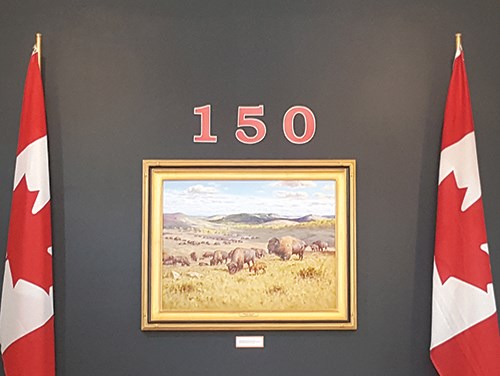The Shurniak Art Gallery presents a beautiful and thought-provoking Canada 150 exhibit for the month of July and August. The exhibit depicts this southwest part of the province from 1867 to the present with agriculture as the dominant theme.
As visitors enter the gallery, their attention is drawn to a magnificent portrait of roaming bison framed by two Canadian flags with the Canada 150 title above. The exhibit works start from this point and are distributed throughout two rooms. The first work depicts what 1867 might have looked like when millions of bison roamed the plains. In the Stonehenge Room a first grouping of paintings illustrates First Nations people adapting to life on reservations. These works reflect the struggle to transition in lifestyle.
The next series of works show life on the prairies for the early pioneers, sawing wood and driving wagons. One grouping depicted a harsh winter scene with wind almost blowing a building away. It reveals the harshness of the elements and the fortitude needed by the early settlers. A summer scene depicts the beauty of the landscape that was also harsh.
Catching the eye is the large-sized amazing work in shimmering gold by Marsha Kennedy mapping Saskatchewan treaties onto the human body.
A centerpiece of the exhibit is a large mosaic of 10 grouped paintings filling most of one wall. Each individual work is packed with scenes depicting each decade of development between 1890 and 2017 in Saskatchewan. It is an absorbing work featuring grain elevators, telephones, the changing technology of farming, veterans, grazing cattle and school buses and many more details. Viewing this piece cannot be rushed.
Some of the works highlight another side of progress. Technological change and improved conditions also mean loss. In several works the iconic grain elevator is centre stage representing a past age and disappearing towns. Several works depict ordinary life on the prairies such as a mother and children harvesting potatoes on the farm or classic images of the south like cowboys on horses and grazing bison.
A trio of works by artist Carl Schlademan feature three views of the same pastoral landscape. One shows a pastoral grasslands landscape as it exists today, and another imagines this location 50 years from now. The third shows a scene of desolation in the future. This work, and indeed the entire set, challenges viewers depicting what could happen to the Saskatchewan prairies if humanity fails to care for the environment.
The exhibit also includes an installation of bird carvings by Francis Bernard Smith of Mossbank. These 3D carvings of lifesized wrens, sandpipers and other local bird life give visitors an appreciation of the diversity of nature in this area. For contemplation and further reading after viewing the exhibit, a selection of books from light reading to academic works has been set up on side tables about Saskatchewan history.
This Canada 150 exhibit accomplishes many purposes. It captures the themes and summarizes in visual art 150 years of the region. One of the functions of art is to challenge viewpoints and stimulate discussion. This carefully designed exhibit is a thought-provoking selection of works. It engages viewers to connect to the past and consider the future of the region.



